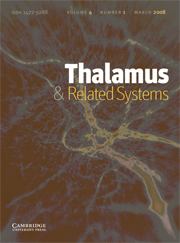Article contents
Pathways for emotions and memory II. Afferent input to the anterior thalamic nuclei from prefrontal, temporal, hypothalamic areas and the basal ganglia in the rhesus monkey
Published online by Cambridge University Press: 18 April 2006
Abstract
The anterior thalamic nuclei are a key link in pathways associated with emotions and memory. In the preceding study we found that one of the anterior nuclei, the anterior medial (AM), had particularly robust connections with specific medial prefrontal and orbitofrontal cortices and moderate connections with frontal polar cortices. The goal of this study was to use a direct approach to determine the sources of projections to the AM nucleus from all prefrontal cortices, as well as from temporal structures and the hypothalamic mammillary body, known for their role in distinct aspects of memory and emotion. We addressed this issue with targeted injections of retrograde fluorescent tracers in the AM nucleus to determine its sources of input.
Projection neurons directed to the AM nucleus were found in the deep layers of most prefrontal cortices (layers V and VI), and were most densely distributed in medial areas 24, 32 and 25, orbitofrontal areas 13 and 25, and lateral areas 10 and 46. Most projection neurons were found in layer VI, though in medial prefrontal cortices and dorsal area 9 about a third were found in layer V, a significantly higher proportion than in lateral and orbitofrontal cortices. In the temporal lobe, projection neurons originated mostly from the hippocampal formation (ammonic field CA3 and subicular complex), and the amygdala (basolateral, lateral, and basomedial nuclei). In the hypothalamus, a significant number of neurons in the ipsilateral medial mammillary body projected to the AM nucleus, some of which were positive for calbindin (CB) or parvalbumin (PV), markers expressed, respectively, in “diffuse” and “specific” pathways in the thalamus [Adv. Neurol. 77 (1998a) 49]. As recipient of diverse signals, the AM nucleus is in a key position to link pathways associated with emotions, and may be an important interface for systems associated with retrieval of information from long-term memory in the process of solving problems within working memory. Finally, the internal segment of the globus pallidus (GPi) issued projections to AM, suggesting direct linkage with executive systems through the basal ganglia. The diverse connections of the AM nucleus may help explain the varied deficits in memory and emotions seen in neurodegenerative and psychiatric diseases affecting the anterior thalamic nuclei.
Information
- Type
- Research Article
- Information
- Copyright
- 2002 Elsevier Science Ltd
- 6
- Cited by

